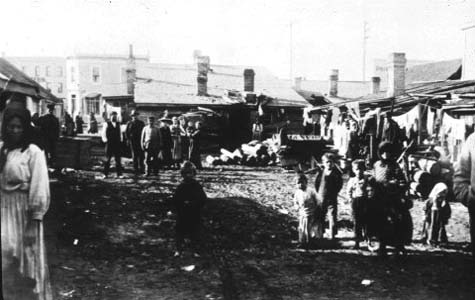Search | Image Archive | Reference | Communities | POV | Lesson Plans | Credits
 For the first thirty years after the city was incorporated in 1874, Winnipeg developed in an environment which favoured growth and gave scarce consideration to public health. It was only in the wake of a severe typhoid epidemic in 1904-5 that the city took meaningful steps to allocate resources to public health.
For the first thirty years after the city was incorporated in 1874, Winnipeg developed in an environment which favoured growth and gave scarce consideration to public health. It was only in the wake of a severe typhoid epidemic in 1904-5 that the city took meaningful steps to allocate resources to public health.
The city's apparent lack of concern for public health was not based on its lack of disease, for in its short history, the community had weathered smallpox, tuberculosis, scarlet fever, and diphtheria. Typhoid fever, locally known as "Red River Fever," which sometimes reached epidemic proportions.
One of the major factors which contributed to the inaction of the civic authorities was that outbreaks tended to be concentrated in certain geographic and economic groups. Most of those that suffered from disease, over-crowding and poor sanitary conditions were concentrated in the North End. This made it easy to blame the problems on the perceived ignorance, sloth and immoral habits of the largely immigrant population.
The typhoid epidemic of 1904-5 represented something of a turning point. Unlike most outbreaks which were concentrated in poorer neighbourhoods, this one was city-wide, and it was later attributed to the contamination of the city's drinking water supply with river water. The penetration of disease into the affluent neighbourhoods in the southern and central parts of the city, together with the efforts of public health activists like Margaret Scott, raised the consciousness of the civic Úlite respecting health issues, and tentative steps were taken towards establishing a public health régime for the city.
In 1904, the city commissioned an inquiry into the causes underlying the epidemica The report, was highly critical of the city, and revealed much about the abysmal sanitary conditions which prevailed. It noted that "certain areas of the city had escaped almost entirely while others seem to have suffered unduly."
The two extremes were the affluent district in Central Winnipeg between Broadway and the Assiniboine River, which had the lowest incidence, and the much poorer area just south of the CP main line and west of Main Street, where the incidence was highest. In the latter area, the connection between typhoid and sanitation was obvious. The investigation discovered on one street a continuous line of outdoor toilets which were allowed to drain freely into the ditch "there being little or no soakage into the ground."
Page revised: 29 August 2009